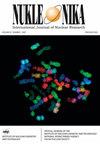Indoor and outdoor 222Rn and 220Rn and their progeny levels surrounding Bayan Obo mine, China
IF 0.3
4区 物理与天体物理
Q4 CHEMISTRY, INORGANIC & NUCLEAR
引用次数: 1
Abstract
Abstract More than half of the total natural ionizing radiation dose received by the human population is caused by radon and thoron (Rn and Tn) and their progeny. To estimate the level of radiation due to radon and thoron and their progeny, an investigation was conducted in a residential area near the world’s largest open-pit mine of Bayan Obo in Inner Mongolia, China. The concentration of Rn, Tn, and their decay products in air and soil were studied by using AlphaGUARD, RAD7, and ERS-RDM-2S for a discrete period of time in three different locations. The average indoor concentration of radon and thoron was 62.6 ± 44.6 Bq/m3 and 108.3 ± 94.5 Bq/m3 respectively, and the outdoor concentration was 12.9 ± 6.3 Bq/m3 and 55.8 ± 18.5 Bq/m3, respectively. Relatively high concentrations were recorded in the area near to the mine, with a significant increasing trend observed in indoor thoron concentration. A prominent hotspot in thoron concentration was found in a single-story house with values 747 ± 150 Bq/m3. The equilibrium equivalent thoron concentration (EECTn) varies from 0.48 Bq/m3 to 2.36 Bq/m3 with an arithmetic mean of 1.37 ± 0.64 Bq/m3, and comparatively higher than EECRn. Concluding that the mining activity at Bayan Obo mine is significantly increasing the level of indoor thoron and its progeny in surroundings. It is suggested to further systematically investigate the indoor Rn and Tn progeny concentrations in the residential dwellings of the Bayan Obo mining area, and 232Th content of the building materials, to provide a basis for calculating the radiation dose.白云鄂博矿区室内外222Rn、220Rn及其子代水平
摘要人类接受的总自然电离辐射剂量的一半以上是由氡和钍(Rn和Tn)及其后代引起的。为了估计氡和钍及其后代的辐射水平,在中国内蒙古白云鄂博世界最大露天矿附近的一个居民区进行了一项调查。使用AlphaGUARD、RAD7和ERS-RDM-2S在三个不同的位置研究了空气和土壤中Rn、Tn及其衰变产物的离散时间。室内氡和钍的平均浓度分别为62.6±44.6 Bq/m3和108.3±94.5 Bq/m3,室外浓度分别为12.9±6.3 Bq/m3、55.8±18.5 Bq/m3。矿井附近区域的浓度相对较高,室内钍浓度呈显著上升趋势。在一栋单层房屋中发现了一个显著的钍浓度热点,其值为747±150 Bq/m3。平衡当量钍浓度(EECTn)在0.48 Bq/m3至2.36 Bq/m3之间变化,算术平均值为1.37±0.64 Bq/m3,相对高于EECRn。结论:白云鄂博矿的采矿活动显著提高了室内钍及其后代在周围环境中的水平。建议进一步系统地调查巴彦奥博矿区居民住宅的室内Rn和Tn子代浓度以及建筑材料中232Th的含量,为计算辐射剂量提供依据。
本文章由计算机程序翻译,如有差异,请以英文原文为准。
求助全文
约1分钟内获得全文
求助全文
来源期刊

Nukleonika
物理-无机化学与核化学
CiteScore
2.00
自引率
0.00%
发文量
5
审稿时长
4-8 weeks
期刊介绍:
"Nukleonika" is an international peer-reviewed, scientific journal publishing original top quality papers on fundamental, experimental, applied and theoretical aspects of nuclear sciences.
The fields of research include:
radiochemistry, radiation measurements, application of radionuclides in various branches of science and technology, chemistry of f-block elements, radiation chemistry, radiation physics, activation analysis, nuclear medicine, radiobiology, radiation safety, nuclear industrial electronics, environmental protection, radioactive wastes, nuclear technologies in material and process engineering, radioisotope diagnostic methods of engineering objects, nuclear physics, nuclear reactors and nuclear power, reactor physics, nuclear safety, fuel cycle, reactor calculations, nuclear chemical engineering, nuclear fusion, plasma physics etc.
 求助内容:
求助内容: 应助结果提醒方式:
应助结果提醒方式:


